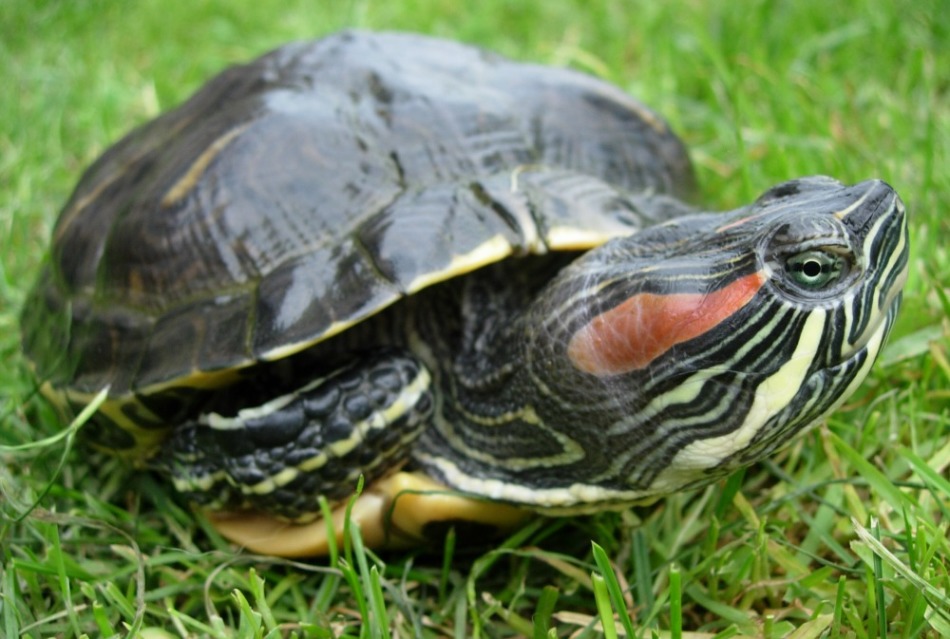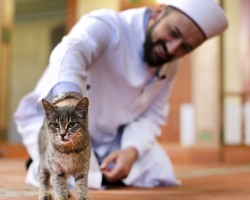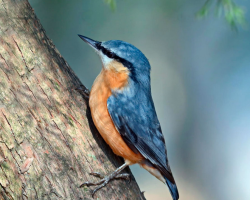In this article we will talk about how not to be confused among the varieties of home turtles and choose a pet.
Content
- Red -haired turtle: The most popular view
- Central Asian Turtle: The most delicate in circulation
- Chinese trionics: the most unusual turtle
- European swamp turtle: a pet flowing into a hibernation
- Muscular turtle: miniature turtle
- Mediterranean turtle: heat -loving pet
- Egyptian turtle: mysterious pet
- Caspian Turtle: Pets-Evpinists
- Indian turtle: the most beautiful turtle
- Ilovaya Turtle: Underfective pet
- Small video about the care of the turtles:
Having decided to have a pet, a fairly large number of people choose turtles. And no wonder: they do not need to be walked, sterilized, combed and remove the flea. They do not spoil the wallpaper and furniture, which delights those who recently made repairs or live in a rented apartment.
Red -haired turtle: The most popular view
Residents of megacities prefer to start this sea turtle in themselves most often. With competent care, she is able to delight the owners at least 30 years!
It's believed that subspecies this breed can be counted about 15. The external trait characteristic of them is all - red or yellow spotsLocalizing in the ears. The paws have strips of saturated green shade. The growth of such individuals is within the limits 18-30 cm.

Important: to determine the age, it is recommended to pay attention to the shell. The younger the turtle, the brighter its shell.
These handsome people are used to living in marshy reservoirs and ponds USA, Mexico, England, Israel, Spain and Australia. Therefore, of course, water For a pet, you need to recreate. But not in the form of a basin with water and a pebble.
Need aquaterrarium is more spent with lamps, filters, thermometer. Water the pet should be approximately at the level 28 degrees, and air - 32. An ideal solution will be the construction island In the middle of the residence of the turtle.
Feed The pet can be small crustaceans, fry fry, small fish without bones. He also loves the larvae of small frogs, insects. A small number of plants will successfully season the dish.
Important: it is worth starting several red -eared turtles at once. Their funny games will amuse both children and adults.

Central Asian Turtle: The most delicate in circulation
Despite the fact that this beauty is present in the Red Book, you can buy it without problems. What many living creatures use. Oddly enough, despite its delicate status, this turtle is often found in captivity. And in the wild - in Central Asia.
This most popular land turtle is scary does not like limited spaces. That is why it is capricious in captivity and may even die.
However, if the owner carefully reacts to the arrangement of the home of the pet, the turtle can feel quite comfortable. That is, you need to prepare a roomy house - an aviary of at least 100 liters. Home requires not only soil, but also sand, pebbles. The Central Asian turtle is passionate about snag Ning, so this floor will be delighted.
In the diet you need to turn on mainly food plant origin. Meat products are not for these beauties. The only thing, sometimes you can treat them with larvae and insects.
Important: but in the most minimal quantities!
This differs extremely slow The pet with a yellow-beige color that allows dark intersperses. The length of the shell is 20-25 cm.

Chinese trionics: the most unusual turtle
Another pet that can be found in the Red Book. But he is not even noteworthy, but what is truly surprising. Trionics belongs to the so -called "Soft -bodied" Turtles. That is, her shell is completely soft due to the fact that they are not covered with horny plates, but by leather. Amazing is and muzzle on a long neck. It flaunts on the muzzle trunks with large nostrils. The length of the adult is 40 cm.

The absence of an armored house of these reptiles with more than compensated by the presence sharp claws and teeth. And also enough fighting character. If the trionics intends to bite, then the bite will turn out to be quite tangible. And, moreover, traumatic.
Important: therefore, it is strongly recommended to purchase such a turtle at a young age - it should get used to its owner. Only then the trionics will not be aggressive.
Chinese amphibians adore fresh water and soft soil. The dwelling of such a pet should be spacious and closed. Temperature water It is preferable to adjust to 25-32 degrees. Of course, it is important to take care of filtration, aeration,sufficient light and warm.
Trionics loves protein food. He can be fed fish, bloodworms, insects, mollusks, meat, worms. However, it is worthwhile to always remember that the trionics are greedy, so it is easy to overfeed in excess of the norms.

European swamp turtle: a pet flowing into a hibernation
The main external distinguishing feature of this turtle is fully black color withoccasionally encountered yellowish interspersed. The shell of this individual smooth and more flat, rather than other turtles. Another distinguishing feature - a long tail. It occupies without exaggeration ¾ the length of the turtle itself. Moreover, the length itself is within the limits 35 cm.
Such amphibian is not considered exotic in our country - it is used to living in Belarus, Russia, Georgia, Armenia. Ponds and lakes are an ideal place for such turtles. Since it is cold in our regions, approximately from October to the end of winter The turtle flows hibernate.
As for home content, you need to take into account the temperature that will have to be maintained. Index water Ideally should be equal 22-25 degrees, air-30. Also, favorites must certainly have their own personal island, on which they will rest.
They prefer swamp turtles fish, meat, insects and crustaceans. It is also recommended to give mineral top dressing. It is curious that such a turtle can be accustomed take food from tweezers - Since she is a predator, she can’t take a quick wit.
Important: you need to remember that adult individuals should be fed 2 or 3 times a week, and young - every day.

Muscular turtle: miniature turtle
The length of the shell of this turtle used to dwell in the southwestern part of the United States, It makes up everything 13.5-14 cm. However, in addition to compactness, she has something to surprise. This amphibian is amazing unpretentious. Any indoor temperatures will be perceived by "cheers".
Like any food. Small fish, shrimp, algae, insects, cabbage, salad - All this turtle will eat with pleasure. Loves and meat, since in natural conditions I was used to feeding on carrion. Therefore, there is a great risk that the pet will slightly pollute the water. It is recommended in this regard or to feed it by stringing it food for a stickor clean the aquarium more often.
However, despite the ease of content, the musky turtle can make a surprise when you feel an approaching danger. And this will be a common problem, unless she gets used to her owners since childhood. The glands located under the shell emit enough repulsive smell.
Important: do not be scared that the turtles spend most of the time under water. This is completely normal for this type.

Mediterranean turtle: heat -loving pet
The second name of this turtle - "Greek." And subspecies She can count her about 20. The largest representatives can boast of the shell length at 35 cm. On the hind legs, peculiar spurs and small horn tubercles flaunt. The front paws are marked with claws in an amount of 5 pieces per each.
In the wild, to live a turtle to live in a wide variety of climatic conditions. Since the range extends throughout European south. Shrubs in the mountains, editorial, steppes, semi -deserts - everywhere this beauty will be comfortable. Especially if the sun's rays are often pleased - in terms of heat There are no equal Greek turtles!
Accordingly, a lot of light and heat is needed in captivity. Lamp It is preferable to pick up with a capacity of at least 40 watts. And best - 60. This reptile is smart enough, so it will select the mode for itself - it will either move away from the lamp or move to it.
Important: but, of course, the real heat from the sun will not replace anything. Therefore, in good weather, you definitely need to take the pet for a walk.
Greek turtles prefer to eat plant foods. Foliage, grass, berries, fruits for them are the most tidbit. Nonetheless, snails, slugs and insects They can also please them.

Egyptian turtle: mysterious pet
Despite the fact that this species is known for science for more than a century, its habits are still studied little. However, scientists immediately noticed that, with the slightest sense of danger, the turtles begin actively drink into the sand. In Egypt, Libya and Israel, Where they come from, it is not difficult to do.
Of course, such conditions should be recreated at home. Some of the owners of the Egyptians prefer to threw a terrarium sand, others mix it with land. But experienced owners of turtles strongly recommend adding Shell - He gives some firmness to the soil, and serves as a source of calcium. It is advisable to create peculiar for turtles shelters “So they will feel more comfortable.”
The temperature should be about 22-24 degrees. About from October to April It needs several lower, since at this time the turtles fall into hibernation.
Once a week Pitomitz is possible bathe. They love to eat plants of the genius genus, herbs, salads and even hay As a source of rough fiber. Important and calcium.
Important: Egyptian turtles cannot be kept one by one. It is preferable to choose a couple. Better yet, keep a group of pets.

Caspian Turtle: Pets-Evpinists
Despite its name, the turtle lives in the wild not only in the territory of the Caspian Sea. Earth from southern Europe to the Middle East They are also familiar with them.
You can recognize such a turtle by large - up to 30 cm -The shell of a dark green shade. You can also notice yellow stripes, and not only on the shell.
Home comfortable content involves installation water temperature within 18-22 degrees, a air - from 30 to 32. It does not hurt to create embankment of pebbles, Since the Caspian turtles are still climbing. They love the abundance of vegetation In reservoirs, what the owner can use for the decor of the terrarium.
The eating of the reptile alternates with the use of sunbathing, minutes of silence in the grass. As soon as it comes Night or period of hibernationShe is in a hurry Growth into the silt. By the way, most of his time the pet will spend exactly under water.
Important: therefore, water should be changed at least once a week.
The menu should consist both from animal and plant food. In the first case, these are fish, meat, worms, bloodworms, insects, tadpoles. In the second - ordinary and sea cabbage, bananas, algae, carrots, leaves from various plants.

Indian turtle: the most beautiful turtle
This reptile is also called "Star." This name refers to love with an unusual shell. It is bugrous and has patterns resembling stars. I must say that on a black background, yellow patterns stand out quite spectacularly. The length of these reptiles is within the limits 25 cm.
This beauty prefers to eat plant foods. Carrots, apples, pumpkin, zucchini, salad, alfalfa, dandelions are ideal.
As a dwelling, it is worth watching there is a larger terrarium And you need to equip it warmer. From 27 to 32 degrees air - This is the norm. If you put several star turtles in it, then they will be extremely peacefully coexist together. Even males will not compete for the territory. However, with other pets, the turtles will look.
The owners will delight the pet year -round, since he hibernation is unnecessarily. After all, in his homeland - in Industan and Sri Lanka There are no cold weather.
Important: with proper care, an Indian turtle can live for 80 years!

Ilovaya Turtle: Underfective pet
The second name of the reptile - "Golovasti." Her head is really so disproportionately great in relation to the shell that it looks unusual. The legs are also large. In general, this turtle is ideal for those people who intend to make a small pet. The length of such turtles does not exceed 18 cm.
By the way, small sizes involve undemanding in the choice of home. If for some breeds you need to buy large terrariums, then that reptile will cost 60-100 liters. They also do not need to create islands - silt turtles prefer live in water. The only thing that the females may be made on land during the period of laying eggs.
Eat prefer food animal origin. Fish, mollusks, low -fat varieties of meat are suitable. Worms and tadpoles will also brighten up the diet. As for the snails, this is a topic for a separate conversation, since the thug of the turtle just loves them!
IMPORTANT: Despite its small parameters, Ilovaya turtle can bite quite noticeably. Therefore, handling it requires accuracy.

The turtle is considered one of the most ancient creatures on Earth. And its views have managed to appear so much that one article is not enough to describe - more than 300. Of course, not all of them are suitable for home content. And we hope that the indicated rating will help to decide those who dream of becoming the owners of the turtle.







